While you can get away with high-level optimization by just pausing certain traffic elements, granular optimization is different. A/B testing different elements is crucial to make sure you squeeze every drop of profit out of your campaign. That’s why we’re going to show you how to get started with A/B testing in affiliate marketing and set up A/B tests for different campaign elements of your affiliate campaigns in Voluum each in just 5 minutes.
What Is A/B Testing?
A/B testing, also known as split testing, is a way to check two different options or ideas and find out which is better. For example, you might have two different headline ideas and you aren’t sure which is better. When you run an A/B test, you show one headline (A) to some website visitors and another option (B) to others. You should then measure for the desired outcome (such as what option leads to the most conversions) and then use the better performing option for everyone.
A/B testing vs Multivariant testing
Multivariant testing is like A/B testing on steroids. Jokes aside, it is a slightly different approach to testing different ideas. When A/B testing, you use two options and decide, which one is the winner.
With multivariant testing, you test several different options and combinations to validate your idea. It’s a broader net thrown upon your visitors, and as such, multivariant testing requires more traffic. But on the other hand, it is a great strategy when starting out with no idea what may work.
A/B Testing Campaign funnel
A/B testing can be conducted on many different elements of a performance marketing campaign including:
- Ad creatives (headline, pictures, copy, call to action)
- Ad Formats
- Traffic sources
- Landing pages elements (read our guide to landing page optimization)
- Offers
- Direct linking vs using a landing page
- Landing page and offer combinations
- Rule-Based Paths and A/B Testing Flows
This is just a sample of the different aspects you can test.
Why Should You A/B Test?
A/B testing in affiliate marketing can provide you with three outcomes
- Identifying the best high-level marketing approach
- Optimizing smaller elements within a campaign
- Investigating future trends and opportunities
When it comes to high-level marketing approaches, you may find that you have several very different options and you aren’t sure what is best for this group or product. For example, you can try a hard sales approach vs a soft sales approach. You can address different buyer personalities.
You shouldn’t use A/B testing for dumb guesses but testing informed theories and is useful for even well-performing elements. It provides a way to make sure your old ideas are still true and trends haven’t changed. That doesn’t mean you should know or even be
Before you start…
To test two or more elements, you need to have those different elements. So if you want to test two landing pages, you need to have created those landing pages. Whereas, when you want to test two offers, you need to have two different offers. Of course, you also need a Voluum account and a source of traffic.
Read our guide how to start Affiliate marketing to learn how to find a good offer, buy traffic and set up a campaign.
Split Testing Offers: The Simplest, but Still Useful, A/B Test You Can Run
One of the simplest things an affiliate can split test is the same offer from two different affiliate networks. This might seem like a strange thing to do, but usually, there are some small but significant differences.
For example, the technology one affiliate network uses to host the offer may only support certain payment types or loads better on a mobile device. These can have a significant impact on the conversion rate.
- Find your two offer to test from different networks. You can use the new offers marketplace to filter and find offers.
- Create a flow that contains both offers split 50/50, here’s how
- Open your Voluum account and click on the flows tab
- Click the “New Flow” button and the New flow window will open
- Create your default path, this will be your “A” option. Set one of your offers here. If you haven’t created any offers, click “create new offer” to add one)
- Next, add your second offer. Click on the “Add offer” button and add your second offer. Again, you can create a new offer here.
- To start optimizing automatically, turn on Traffic Distribution AI for the paths
- Give the flow a name, and click next. You’ve now created your A/B Test flow
- Either create a new campaign with this flow as your destination option or edit an existing campaign and change the destination to use this new flow.
You could create a single path instead of using flows, however, creating a flow means you can reuse this flow in other campaigns (to test other traffic sources) and gives you the option to test both landing pages and offers. You can also set up more granular optimizations using Rule-based paths later.
A/B Testing Direct Linking vs Using a Landing Page
In some situations, it’s better to send traffic directly to an offer, in other situations a landing page can add extra power that is vital for conversions. While there are some general trends in terms of traffic types and verticals that prefer landing pages, it’s a good and easy A/B test to run just to make sure you are doing the best option.
- Create a new flow in Voluum (either as you create a campaign or clicking “New flow” in the Flows tab).
- Click on the first path (called new path) and give it the name like “direct linking”.
- select the “direct linking” checkbox.
- Now select your offer (you can create a new offer element by clicking “create new offer”).
- Create your path with a landing page by clicking “Add default path”.
- Give this path a name like “landing page path”.
- Select a lander element for your landing page (or create one if you haven’t already).
- Add the same offer as the direct linking path.
- Optionally, activate Traffic Distribution AI to automatically redistribute your traffic to the option that performs the best.
You can combine this A/B test with testing the same offer in multiple networks by adding the different offers to each path.
A/B Testing Different Landing Pages
The final piece of the funnel is landing pages. Using a flow is for testing multiple landing pages can be useful when you start a campaign to identify which design or copywriting approach works better (read our guide on optimizing landing pages for ideas to test). It is also useful when you have a campaign running and find that your landing page is underperforming on certain traffic and need to find a better option.
Before we start, make sure you have the different landing pages you want to test and you have created landing page elements in Voluum to track their performance. The second step can be done during setup but might take slightly more than our five-minute time limit.
- Create a new flow in Voluum.
- Click on the first path and give it a descriptive name (for example “Landing page, Question headline”),
- Select the lander related to your first landing page
- Select the offer or offers that you want to test.
- Create a new path and give it a descriptive name (for example “Landing page, Action headline”
- Select the lander that is related to your alternative landing page that you wish to test
- Select the offer that you want to test
- Optionally, activate Traffic Distribution AI on the features you wish to optimize. For example, you can activate it on both your two paths to send more traffic to the combination which works best but also activate it on offers within these paths, each path will optimize towards the best offer.
There are even more complex options for A/B testing in affiliate marketing that you might want to try. For example,
- Setting up a specific landing page and offer combination and comparing it with a landing page and offer combination (lander 1 and offer 1 vs lander 2 and offer 2)
- Testing two landing pages which both send traffic to two offers to find which combination is the best (lander 1 & offer 1/2 vs lander 2 & offer 1/2)
- Comparing direct linking and multiple landing pages, offers, and combinations of landers and offers.
All you need to do is create the paths you want to test.
A/B Testing Ads
To A/B test adverts, you need to set up your test on the traffic source side. If they support impression tracking and custom variables, then you can also measure and compare your creatives’ effectiveness in Voluum.
Even if a traffic source doesn’t support A/B testing of ads, you can run multiple campaigns, set up the same but with different creatives and give them different names in Voluum so you can track their performance.
If you use our supported traffic source (Zeropark) then you can track your ads’ performance.
A/B Test Your Traffic Sources
Traffic sources can have a dramatic impact on your campaign performance and it’s really easy to test in Voluum. In this case, you need to create two campaigns each using different traffic sources but the same paths.
To save time, create a reusable “flow” in Voluum which is reusable and synchronizes changes you make (so you can add more rule-based paths later). Once you have created your campaigns, compare the results in your reports. You may see one clear winner, or you may discover that one traffic source is better for types.
You can create a complex set of rule-based paths and A/B tests as a flow, then you can set up the same campaign. This is exactly what Adextrem does, allowing them to scale their operations quickly and test many different sources.
A/B Testing in Affiliate Marketing Without Traffic Distribution AI
You don’t have to use Traffic Distribution AI to run an A/B test and there are some occasions when you might not want to. These include when you are running very small amounts of traffic (Traffic Distribution AI needs a certain amount of data to draw conclusions. If you are buying very little traffic, then you won’t get enough data to be useful. In many cases, this is true of all optimization efforts.)
In this case, you need to calculate how much data you need to know if one option is more effective than the other and then manually review yourself. You also need to work out the criteria for measuring the effectiveness of your A/B test. This generally means click through rate and conversion rate in combination.
- A higher click-through rate but lower conversion rate may mean the offer is ineffective, or that your landing page doesn’t encourage the right people to click through.
- A lower click-through rate but higher conversion rate may mean that the lander is too selective
Of course, most of the time, one option will have a higher Click-through rate and Conversion rate which is great (or lower in both…try again).
Rule-Based Paths and A/B Testing Flows
Now you understand the basics of A/B testing in affiliate marketing with Voluum, it’s worth looking into how you can combine A/B tests with Rule-Based Paths.
Rule-based paths allow you to redirect traffic based on a series of criteria. Common optimizations include using different landing pages for mobile users, or using different landing pages and offers for different OS options (it’s better to bring someone to a mac download page if they are using a Mac, and a PC download if they are using a PC).
Traditionally, you’d have to wait to get some data and identify some of these differences. But with A/B testing you can easily devote some of your budget to testing a new idea and instantly take advantage of those which work. You can set a default weight (say 20 based on the Pareto principle of experimentation) and then it will adjust from there if it is more or less effective.
Combine Rule-Based Paths and Traffic Distribution AI for immediate performance boosts
Sometimes, one landing page performs better for one segment of traffic and another does better for a different segment. It’s not always easy to predict these results as sometimes a different headline will work better with mobile traffic and another works better with desktop traffic.
Continuing this example, if you had more desktop traffic than mobile and were only A/B testing your two paths (using Traffic Distribution AI) then the AI would start sending more of the traffic to the desktop offer.
There is an easy way to avoid this.
Create Rule-based paths based on high-level optimizations such as desktop vs mobile or individual operating systems. You need a statistically significant amount of traffic so you shouldn’t do this on every possible variation (from the start).
To get that statistically significant data on more granular observations, you need to employ another simple trick.
Look at the performance of the campaign elements, not the campaign itself.
Seeing as you are using the same landing page or offer across these paths, you can look a the performance on the lander or offer elements and notice patterns there for differences between connection types, cities or referrer.
Always Be A/B Testing
There you have it. There are lots of different parts of your campaign that you can, and should, A/B test with Voluum. In some cases, Voluum can not set up the testing but can help you track the effectiveness of your tests. But in other areas, you can not only track, but also optimize.

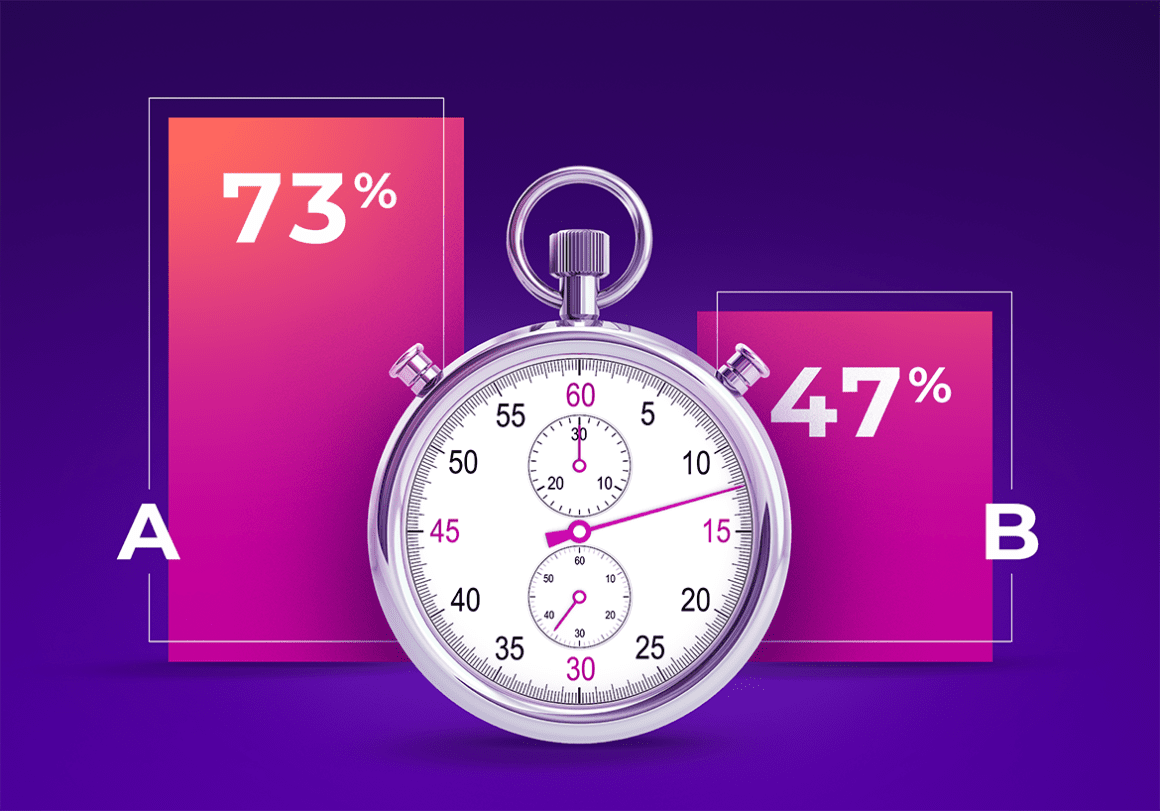
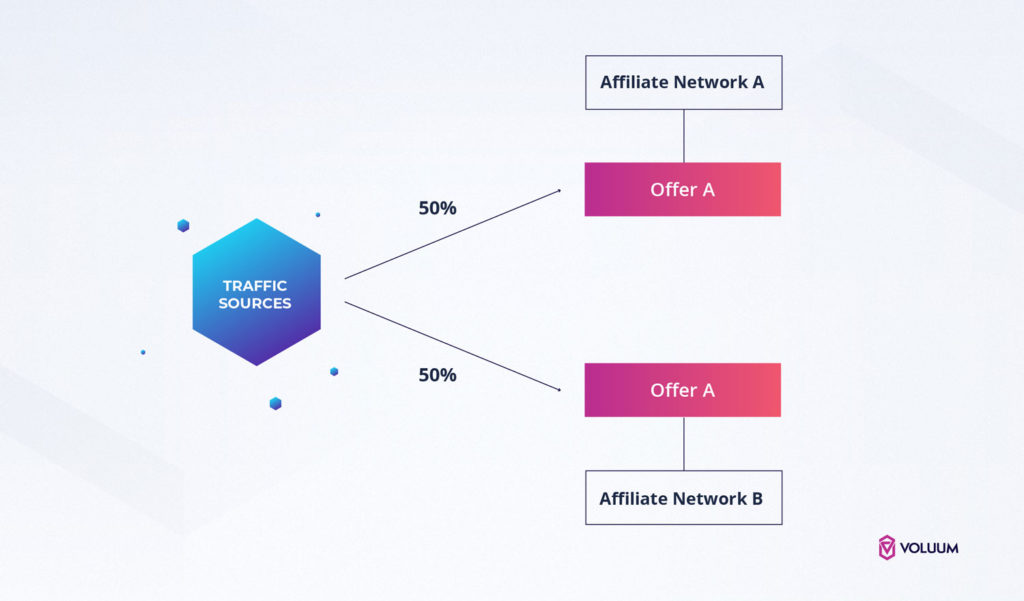
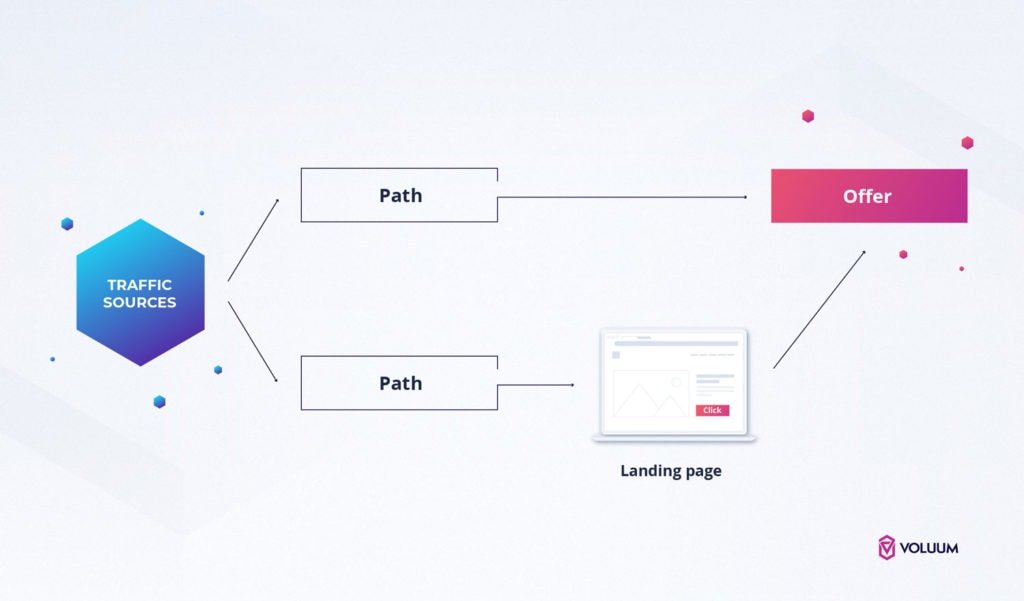
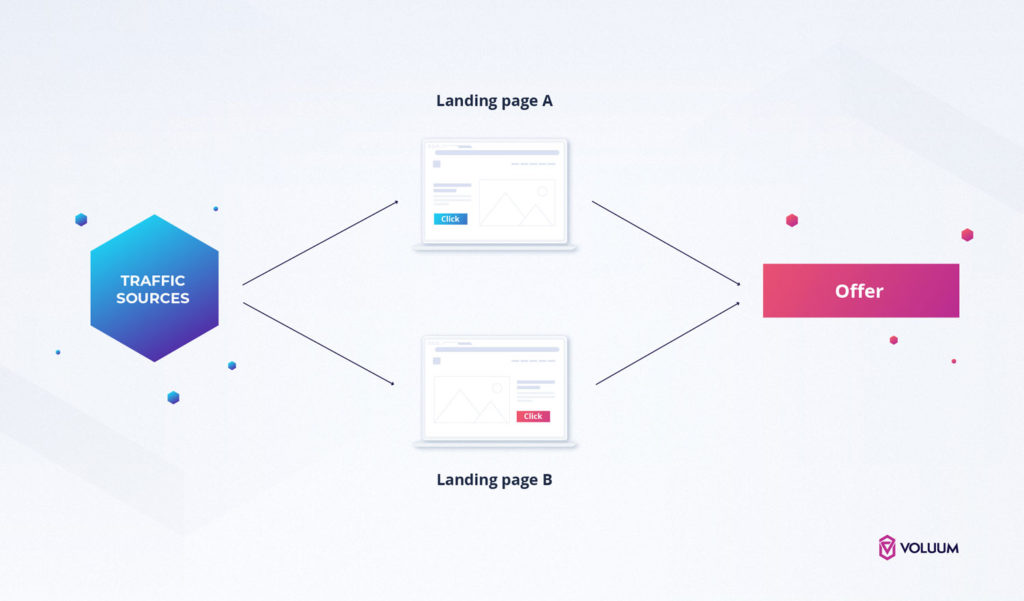
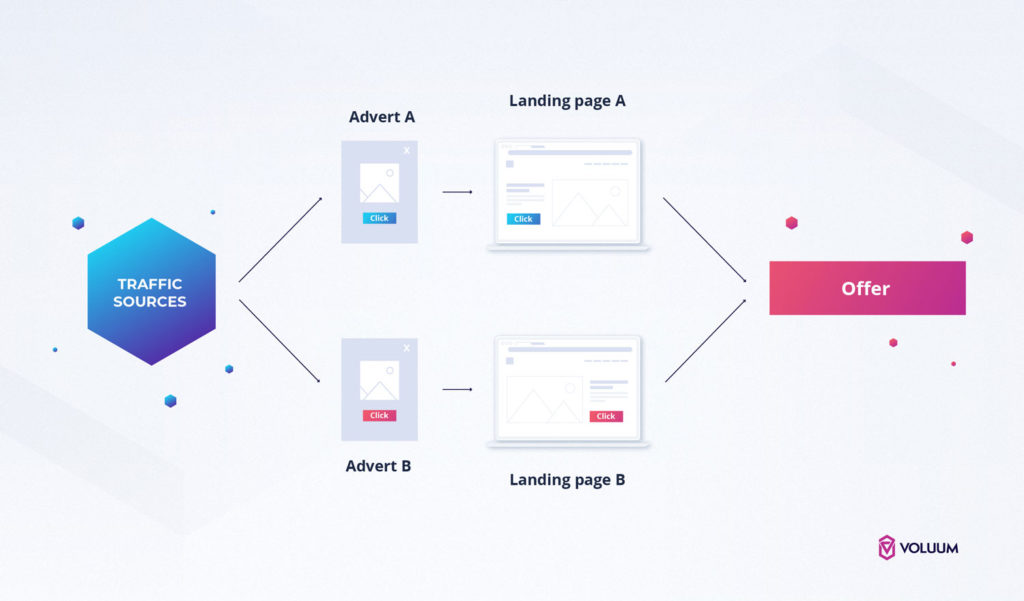
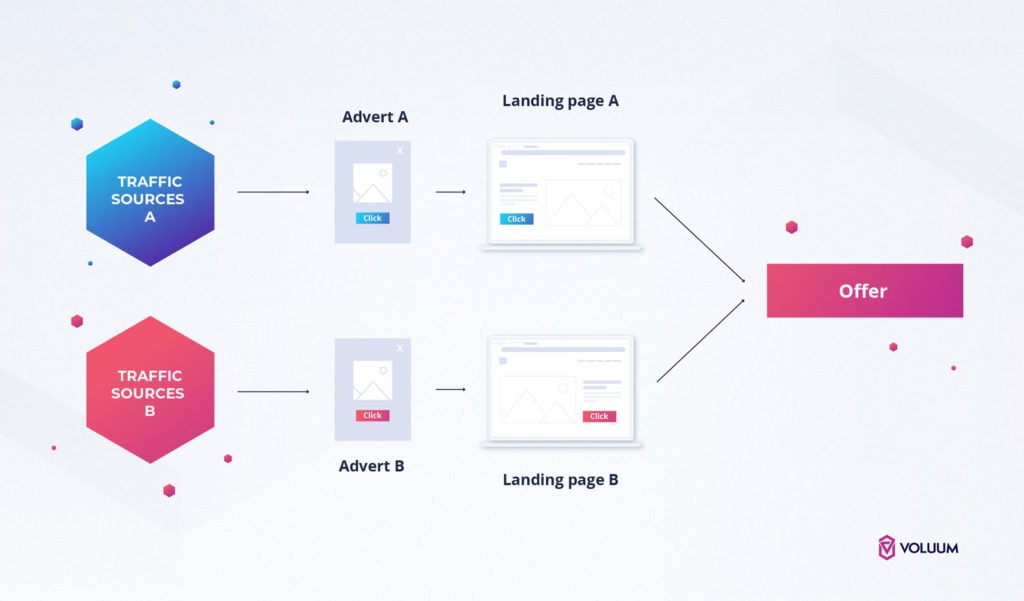



One comment
Awesome!
Thanks for sharing valuable information about A/B testing, A/B testing offers and A/B testing in affiliate marketing.